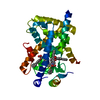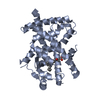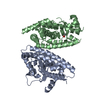Entry Database : PDB / ID : 8hhqTitle Covalent bond formation between cysteine of PPARg-LBD and iodoacetic acid Peroxisome proliferator-activated receptor gamma Keywords / / / / Function / homology Function Domain/homology Component
/ / / / / / / / / / / / / / / / / / / / / / / / / / / / / / / / / / / / / / / / / / / / / / / / / / / / / / / / / / / / / / / / / / / / / / / / / / / / / / / / / / / / / / / / / / / / / / / / / / / / / / / / / / / / / / / / / / / / / / / / / / / / / / / / / / / / / Biological species Homo sapiens (human)Method / / Resolution : 2.4 Å Authors Kojima, H. / Itoh, T. Funding support Organization Grant number Country Japan Agency for Medical Research and Development (AMED)
Journal : J.Med.Chem. / Year : 2023Title : Covalent Modifier Discovery Using Hydrogen/Deuterium Exchange-Mass Spectrometry.Authors : Kojima, H. / Yanagi, R. / Higuchi, E. / Yoshizawa, M. / Shimodaira, T. / Kumagai, M. / Kyoya, T. / Sekine, M. / Egawa, D. / Ohashi, N. / Ishida, H. / Yamamoto, K. / Itoh, T. History Deposition Nov 16, 2022 Deposition site / Processing site Revision 1.0 Sep 20, 2023 Provider / Type Revision 2.0 Nov 15, 2023 Group / Data collection / Derived calculationsCategory atom_site / chem_comp_atom ... atom_site / chem_comp_atom / chem_comp_bond / struct_conn Item _atom_site.auth_atom_id / _atom_site.label_atom_id ... _atom_site.auth_atom_id / _atom_site.label_atom_id / _chem_comp_atom.atom_id / _chem_comp_bond.atom_id_1 / _chem_comp_bond.atom_id_2 / _struct_conn.ptnr2_label_atom_id Revision 2.1 Sep 17, 2025 Group / Derived calculations / Structure summaryCategory pdbx_entry_details / pdbx_unobs_or_zero_occ_atoms ... pdbx_entry_details / pdbx_unobs_or_zero_occ_atoms / pdbx_validate_close_contact / struct_conn Item
Show all Show less
 Yorodumi
Yorodumi Open data
Open data Basic information
Basic information Components
Components Keywords
Keywords Function and homology information
Function and homology information Homo sapiens (human)
Homo sapiens (human) X-RAY DIFFRACTION /
X-RAY DIFFRACTION /  MOLECULAR REPLACEMENT / Resolution: 2.4 Å
MOLECULAR REPLACEMENT / Resolution: 2.4 Å  Authors
Authors Japan, 1items
Japan, 1items  Citation
Citation Journal: J.Med.Chem. / Year: 2023
Journal: J.Med.Chem. / Year: 2023 Structure visualization
Structure visualization Molmil
Molmil Jmol/JSmol
Jmol/JSmol Downloads & links
Downloads & links Download
Download 8hhq.cif.gz
8hhq.cif.gz PDBx/mmCIF format
PDBx/mmCIF format pdb8hhq.ent.gz
pdb8hhq.ent.gz PDB format
PDB format 8hhq.json.gz
8hhq.json.gz PDBx/mmJSON format
PDBx/mmJSON format Other downloads
Other downloads 8hhq_validation.pdf.gz
8hhq_validation.pdf.gz wwPDB validaton report
wwPDB validaton report 8hhq_full_validation.pdf.gz
8hhq_full_validation.pdf.gz 8hhq_validation.xml.gz
8hhq_validation.xml.gz 8hhq_validation.cif.gz
8hhq_validation.cif.gz https://data.pdbj.org/pub/pdb/validation_reports/hh/8hhq
https://data.pdbj.org/pub/pdb/validation_reports/hh/8hhq ftp://data.pdbj.org/pub/pdb/validation_reports/hh/8hhq
ftp://data.pdbj.org/pub/pdb/validation_reports/hh/8hhq

 F&H Search
F&H Search Links
Links Assembly
Assembly

 Components
Components Homo sapiens (human) / Gene: PPARG / Production host:
Homo sapiens (human) / Gene: PPARG / Production host: 
 X-RAY DIFFRACTION / Number of used crystals: 1
X-RAY DIFFRACTION / Number of used crystals: 1  Sample preparation
Sample preparation ROTATING ANODE / Type: RIGAKU R-AXIS II / Wavelength: 1 Å
ROTATING ANODE / Type: RIGAKU R-AXIS II / Wavelength: 1 Å Processing
Processing MOLECULAR REPLACEMENT
MOLECULAR REPLACEMENT Movie
Movie Controller
Controller


 PDBj
PDBj

